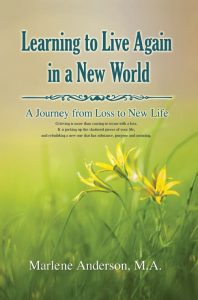Listen to this episode of the Focus with Marlene Podcast
Click here to get caught up on all episodes in this series on recovering from loss
When you learn the basics of problem-solving it will be a skill that you use automatically.
In last week’s post, I outlined five basic components of problem solving; questions you need to ask to find the solution you want. Today you will set the criteria to resolve your problem and learn how to identify exactly what the main problem is.
Identify the problem – define the conflict
Whether the question is how to advance beyond basic survival, how to prepare for your financial future, or how to better communicate with your spouse, it is crucial that the problem be correctly defined.
Unless the problem is correctly defined, you will be trying to rid yourself of emotional distress rather than resolving the actual problem.
Many problems involve our relationships with others: spouse, children, in-laws, neighbors, co-workers, bosses, etc. Until we know how this conflict is affecting all parties involved, we will not be able to adequately separate symptoms from the problem.
Step out of the emotional space for a minute and focus on what is causing you to feel that anger, worry or distress.
What is the actual problem? Do others see it the same way?
Symptoms
Symptoms are the emotional upset you are feeling, and the ongoing conflict affecting life on a daily basis. Problems affect the behaviors of everyone, sometimes through defensive actions, other times through aggressive action or inaction.
Sometimes problems will have us withdraw from any communication, fearful of making the matter worse. Unaddressed, the problem keeps us from listening or communicating at all. Sleep is affected, as are relaxation times. Life has lost all pleasure.
Who is involved?
When the conflict you are experiencing involves others, the perspective of both people needs to be considered.
- Does the other person see a problem or just you?
- How does the problem impact each of you?
- Can you adequately define how you are being affected?
- Can you listen with an open mind?
It is often difficult to hear another’s point of view. Everybody sees the world differently.
Before problems involving one or more people can be resolved, clarification of both person’s perspective is necessary.
In intimate relationships, emotions can quickly run high along with misinterpretation and misunderstanding. When both people are willing to take time to articulate their opinions, personal perceptions, assumptions, and expectations, and listen to the other person, problems can be successfully worked on.
You can’t tell another person how they should feel or what should be important to them, but you can stop and examine your motives and what is important to you and why.
Is it more important to win an argument, or to work towards a positive resolution?
Is winning more important than the relationship?
If your relationship is meaningful, you will probably have a sincere willingness to listen and understand the other’s point of view.
- What can both of you accept and live with?
- What can’t you accept?
- What sacrifices are you willing to make?
- What are the alternatives and the impact it might have over time?
Setting the stage for sincere discussion
Whenever a problem involves other people, choose a time and place when you can have a sincere discussion, a time when you both can listen as well as emote, without time pressure. If this is a conflict that involves all family members, ask for a family meeting where the problem can be addressed, and everybody can be heard. Set a time that everyone can agree to.
Holding regular family meetings can be very productive because kids are able to voice their concerns, and everyone has input. It is a time when parents can define the rules and explain why they are necessary. In my parenting classes, regular family meetings were encouraged. It can prevent many problems from getting out of hand.
Discussion includes feelings and behaviors. We become vulnerable and defensive. To actively listen, if you are unsure what was intended, stop, and ask for clarification.
Example: I want to better understand our differences and what specifically you would like to have happen. Is this what you meant? If not, would you explain it to me again?
Say it in a proactive way that encourages further discussion rather than defending/attacking. You can then share what you want and need.
Setting criteria for the outcome
Before you can brainstorm solutions, you need to have criteria identified and written down for what needs to happen for this problem to be resolved.
Gather all the relevant facts. Then brainstorm ways to reach that solution.
Set some rules you both can agree to while working together, such as showing respect, no name calling or labels, a willingness to listen, asking questions politely, and requesting a time-out if emotions get high.
Take the problem apart and look at it from every angle
- What are you personally willing to do to arrive at a solution?
- What personal biases would keep you from working on finding a potential solution?
- What obstacles do you put up preventing a positive outcome?
Look at the problem forwards and backwards, inside and out. Let it permeate your unconscious. Experience it in as many different ways as possible.
Visualize a solution
Challenge old expectations and assumptions. Break away from rigid patterns. Be willing to try something new.
Re-examine pieces of the problem rather than just rearranging it. Problem-solving assumes certain boundaries. There are things you will not do, and you share that.
Finding answers requires forward thinking and suspending judgement.
It is important not to prejudge any ideas before you have explored their validity. That is especially true for the ideas others present. When we suspend judgement, we can explore more options, think about how each idea might be useful and take the time to evaluate before eliminating.
 Learning to Live Again in a New World
Learning to Live Again in a New World
We need validation for the turmoil of thoughts and emotions we experience. But we also need the tools necessary to create a new beginning that is both satisfying and meaningful. My new book, Learning to Live Again in a New World, offers those tools to help work through the problems you might be facing.
It is a guide to help you through the ups and downs of grieving a significant loss. And it includes a study guide at the end for use with groups.
Marlene Anderson


